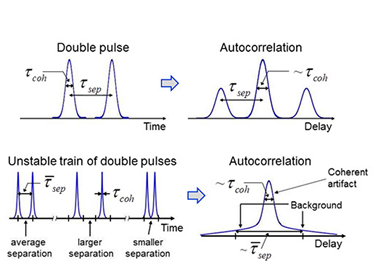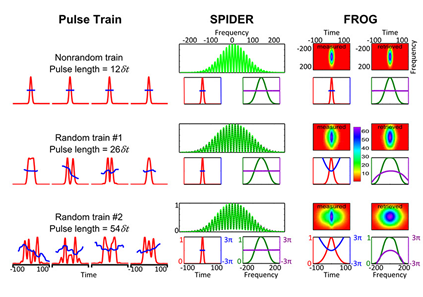By Dr. Rick Trebino
By Dr. Rick Trebino, Georgia Institute of Technology Ultrafast Optics Group
An excerpt from SC378: Introduction to Ultrafast Optics
When a measurement averages over many different events, it faces an impossible task: Providing one result when no one result can be correct. In ultrafast optics, this issue has been particularly problematic when using the traditional method of measuring for laser pulses, called intensity autocorrelation and introduced in the 1960’s. When autocorrelation was used to measure trains of different, complex pulses, the resulting measured autocorrelation trace vs. delay (Figure 1.) consisted of a narrow spike atop a broad structureless background. Early researchers often mistook the spike, or “coherent artifact,” for the measure of their pulse length, but its width actually only indicates the much shorter, nonrandom (“coherent”) component of the pulse. The correct pulse length is actually almost always much longer and is instead indicated by the temporally much broader background, which also takes into account the much longer, random (“incoherent”) pulse component.
Given that the task is inherently impossible, it’s worth asking what we should expect. The answer is that the technique should yield a pulse with some characteristics of the typical pulse in the train (e.g., its duration), but, more importantly give an indication of the stability, or randomness, of the pulses in the train.
Although autocorrelation actually does yield some of this information, it yields neither the pulse intensity nor its phase even for the simple case of a stable train of identical pulses and so is now generally considered obsolete.

Figure 1. Top: A double pulse and its autocorrelation. Bottom: A train of randomly separated double pulses and their multi-shot autocorrelation (averaged over many pulses in the train). The coherent artifact results from the short nonrandom coherent component of the double pulses (specifically, a single pulse), while the broader background results from the overall average pulse length (the combination of both pulses). This trace is typical of autocorrelations of nearly all trains of unstable complex pulses.

Figure 2. Top: a stable train of short pulses and its measurement by two modern techniques, SPIDER and FROG. Middle and bottom: Two unstable pulse trains of different average complexity and duration and their measurement. SPIDER yields the same very short pulse (coherent artifact) for all three trains. FROG, on the other hand, yields the correct pulse length, and also indicates the presence of instability.
Figure 2 shows one stable and two unstable pulse trains of varying complexity, and simulated multi-shot measurements of them using two modern pulse-measurement techniques, SPIDER and FROG. Red curves indicate the intensity vs. time, blue the phase vs. time, green the spectrum, and purple the spectral phase.
The stable train of short pulses and unstable trains of longer pulses cannot be distinguished by SPIDER, which always yields the short nonrandom component of the pulses. In short, SPIDER only measures the coherent artifact. As a result, it probably cannot be used to measure pulse lengths.
FROG also does not see the pulse structure, but it does yield the correct durations. More importantly, in FROG, the measured FROG trace and retrieved FROG trace (that computed from the measured intensity and phase) disagree for the random trains. This is the key: such disagreement in FROG is the indication that instability is present.
SPIDER’s failure should not be surprising: it’s been known for over 200 years that interferometric methods (of which SPIDER is one), in general, are not sensitive to random phase variations, responding only with reduced fringe visibility and increased background. Worse, most other modern pulse-measurement techniques are also interferometric and so also measure only the coherent artifact! Because there is no other indicator available for such instability, most pulse-length claims using these modern techniques require re-evaluation.
So how did some of the brightest scientists in the world make the same mistake twice? Most likely, it was wishful thinking: many ultrafast scientists like to be able to brag about having extremely short pulses, and interferometric techniques routinely provide them. But as scientists, we owe it to ourselves, the scientific community, and humankind to be better than this.
About Professor Rick Trebino
Professor Trebino is the co-inventor of FROG and the inventor of GRENOUILLE and a host of other clever techniques for measuring ultrashort laser pulses. He has received wide recognition for this work, including an R&D100 award, a Prism award, a Circle of Excellence award, and the SPIE’s
Edgerton Prize for developments in ultrafast measurement technology, and he is a Fellow of the OSA, APS, SPIE, and AAAS.
Posted: 15 May 2015 by
Dr. Rick Trebino
| with 0 comments